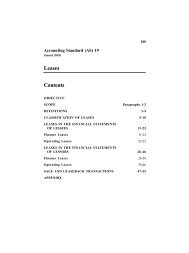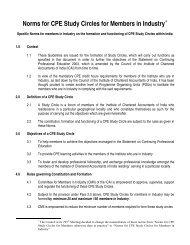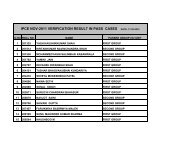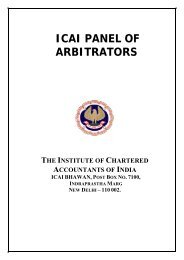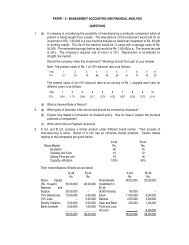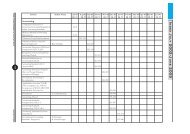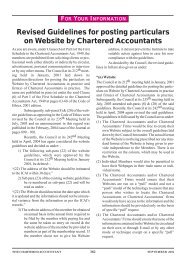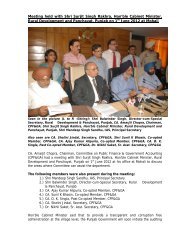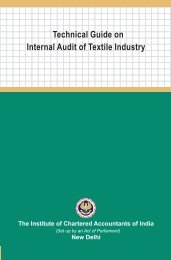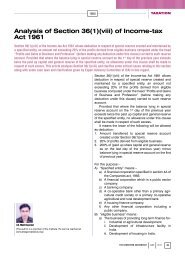The Chartered Accountant
The Chartered Accountant
The Chartered Accountant
You also want an ePaper? Increase the reach of your titles
YUMPU automatically turns print PDFs into web optimized ePapers that Google loves.
for which controls are being<br />
assessed;<br />
q assessing the susceptibility to<br />
misuse of resources, failure to<br />
attain objectives regarding ethics,<br />
economy, efficiency and effectiveness,<br />
or failure to fulfil<br />
accountability obligations, and<br />
non-compliance with laws and<br />
regulations;<br />
q identifying and understanding<br />
the design and operation of<br />
relevant controls;<br />
q determining the degree of<br />
control effectiveness through<br />
testing of controls;<br />
q assessing the adequacy of the<br />
control design;<br />
q reporting on the internal control<br />
evaluation and discussing<br />
the necessary corrective actions.<br />
10. <strong>The</strong> broad areas of review by the<br />
internal auditor in evaluating the<br />
internal control system, inter alia,<br />
are:<br />
q Mission, Vision, Ethical and<br />
Organizational Value-system<br />
of the entity.<br />
q Personnel allocation, Appraisal<br />
system, and Development policies.<br />
q Accounting and financial reporting<br />
policies and compliance<br />
with applicable legal and<br />
regulatory standards.<br />
q Objective of measurement and<br />
key performance indicators.<br />
q Documentation standards.<br />
q Risk management structure.<br />
q Operational framework.<br />
q Processes and procedures followed.<br />
q Degree of management supervision.<br />
q Information systems.<br />
q Communication channels.<br />
DECEMBER 2008 1114 THE CHARTERED ACCOUNTANT<br />
EXPOSURE DRAFTS<br />
q Business Continuity and Disaster<br />
Recovery Procedures.<br />
11. <strong>The</strong> internal auditor should<br />
obtain an understanding of the<br />
significant processes and internal<br />
control systems sufficient to plan<br />
the internal audit engagement<br />
and develop an effective audit<br />
approach. <strong>The</strong> internal auditor<br />
should use professional judgment<br />
to assess and evaluate the maturity<br />
of the entity’s internal control.<br />
<strong>The</strong> auditor should obtain<br />
an understanding of the control<br />
environment sufficient to assess<br />
management’s attitudes, awareness<br />
and actions regarding internal<br />
controls and their importance<br />
in the entity. Such an understanding<br />
would also help the internal auditor<br />
to make a preliminary assessment of<br />
the adequacy of the accounting and<br />
internal control systems as a basis<br />
for the preparation of the financial<br />
statements, and of the likely nature,<br />
timing and extent of internal audit<br />
procedures. <strong>The</strong> internal auditors assesses<br />
the ‘as –is’ internal control system<br />
within the organization .<br />
12. <strong>The</strong> internal auditor should<br />
obtain an understanding of the<br />
internal control procedures sufficient<br />
to develop the audit plan. In<br />
obtaining this understanding, the internal<br />
auditor would consider knowledge<br />
about the presence or absence<br />
of control procedures obtained from<br />
the understanding of the control environment,<br />
business processes and<br />
accounting system in determining<br />
whether any additional understanding<br />
of control procedures is necessary.<br />
<strong>The</strong> internal auditor should<br />
document and understand the<br />
design and operations of internal<br />
controls to evaluate the effectiveness<br />
of the control environment.<br />
<strong>The</strong> important procedures to be adopted<br />
by the internal auditor for this<br />
purpose are:<br />
q Narratives<br />
q Flowcharts<br />
q Questionnaires<br />
13. When obtaining an understanding<br />
of the business processes, accounting<br />
and internal control systems<br />
to plan the audit, the internal auditor<br />
obtains a knowledge of the design<br />
of the internal control systems and<br />
their operation. For example, an internal<br />
auditor may perform a “walkthrough”<br />
test that is, tracing a few<br />
transactions through the accounting<br />
system. When the transactions selected<br />
are typical of those transactions<br />
that pass through the system,<br />
this procedure may be treated as part<br />
of the tests of control.<br />
14. <strong>The</strong> internal auditor should<br />
consider the following aspects in<br />
the evaluation of internal control<br />
system in an entity:<br />
q Ascertaining whether the<br />
entity has a mission statement<br />
and written goals and<br />
objectives.<br />
q Assessing risks at the entity<br />
level.<br />
q Assessing risks at the activity<br />
(or process) level.<br />
q Completing a Business Controls<br />
Worksheet for each significant<br />
activity (or process)<br />
in each function or department<br />
with documentation<br />
of the associated controls<br />
and their degree of effectiveness<br />
(partial or full); prioritizing<br />
those activities (or<br />
processes) which are most<br />
critical to the success of the<br />
function or department.<br />
q Ensuring that all risks identified<br />
at the entity and function<br />
or department level are<br />
addressed in the Business<br />
Controls Worksheet along<br />
with the consolidated documentation<br />
of the operating<br />
controls.<br />
q Ascertaining from the Business<br />
Controls Worksheet,<br />
those risks for which no controls<br />
exist or existing controls<br />
are inadequate. This



